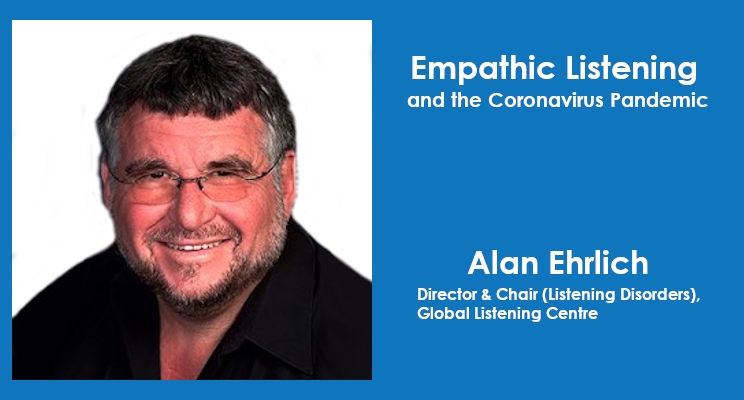
Empathic Listening and the Coronavirus Pandemic
Imagine, if you will, feeling ill—headache, fever—you’ve lost your sense of taste and smell, and it is getting a bit difficult to breathe comfortably. After weeks in self-isolation, you’re taken to the hospital which now has a series of triage tents lining the front walk. After navigating the first tent you’re told that you could possibly have contracted the Coronavirus and from that point on, you can no longer have the comfort of your family members with you. The highly contagious nature of this virus means that you will traverse the healthcare system—and your treatment—without your spouse, children, parents, or friends. They must remain outside—you’re now in isolation. Both medically and socially.
In the hospital, amorphous human-shaped forms float in what looks like a sea of blue paper and gloved hands. Where their heads should be, layers of cloth behind a plastic window shield weary eyes, many in tears.
As alone as you may feel, you’re not alone. There is a building full of patients in the same situation that you are. Alone, vulnerable and scared.
As humans, we all have a basic need—an instinct—to connect with other humans and, being in the hospital, there is a stark realization that this virus, this expansive pandemic, has made this need all but impossible to fulfill.
Many of the amorphous blue shapes floating around are nurses, some exhausted from working multiple shifts because of the high number of critical patients. One comes over and peering through the plexiglass shield, simply asks “How are you doing?” and a human connection, a critical, often life-saving human connection is formed.
The simple question “How are you doing?” is a key element in successful empathic listening, or paying attention to another person with compassion, feeling, insight, and emotional identification. It requires connecting at both emotional and cognitive levels allowing each person to both understand and be understood.
The most basic of all human needs is the need to understand and be understood. The best way to understand people is to listen to them —Ralph Nichols.
In these super-stressful, pandemic times, a nurse is not only the front-line in the battle against the deadly effects of the Coronavirus but they are also the front-line human who listens to your fears, your sense of helplessness, and all too often your final words.
Most of us put little effort or thought into our listening; we just listen. We hear a sound and then, consciously or unconsciously, we process the sound in our brain, recognize it, categorize it—as a bird chirping, an emergency vehicle siren, or lingual information—someone speaking.
But listening is situational. We choose to listen differently in different situations. For example, when we listen to a musical performance we can listen for pure enjoyment, listen to learn the rhythm, structure or melody line, or we can critically listen in the way a teacher might in order to evaluate a student’s performance.
In much the same way, we can listen to someone talking and choose to engage with them or just skim over the words they’re saying. We can dig deeper into the topic by asking targeted, subject-oriented questions, or we can focus on the person and engage with them by trying to understand their fears and feelings.
Nurses today have to accomplish both—extracting important factual data (medical history, current symptoms, etc.)—all while knowing that the patient is suddenly alone and needs to have their fears and feelings listened to.
While we have spent a lifetime listening to and extracting pertinent information, many people find that listening to a person’s feelings and fears can be not only difficult, but intimidating. Empathic listening requires that you be non-judgmental, so listen with a completely open mind, do not provide advice or solutions, nor provide reasons why the person shouldn’t feel the way they do.
A good empathic listener will provide their undivided attention, listen with all of their senses, paraphrase the person’s feelings to demonstrate understanding, and allow for periods, sometimes long, of silence and reflection.
Imagine, if you will, a nurse standing between two beds. The patient in one is nearing death and is only worried about the cost of treatment and who will pay for it. In the other bed is a patient that just arrived with all of the fears and anxiety of being separated from family and friends and requires that a complete medical history be taken.
The nurse has to demonstrate an incredible level of agility in their listening ability. The lives of their patients are in their hands. In the words of Mr. Rogers :
In times of stress, the best thing we can do for each other is to listen with our ears and our hearts and to be assured that our questions are just as important as our answers.
